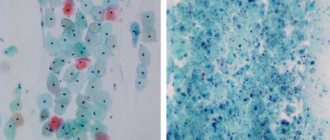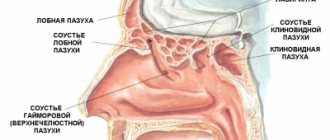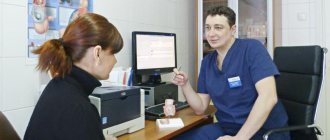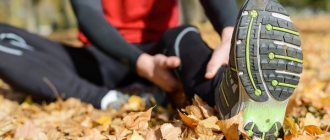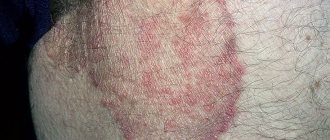Causes of itching
The content of the article
Sarcoptes scabiei are arthropods that live on the skin of mammals. Most often, areas of the skin that do not contain a large number of sebaceous glands are affected, since sebum prevents the proliferation of parasites. In addition to humans, it can infect other mammals - dogs, cats, wild boars, monkeys, koalas and others.
It is smaller than 0.5 mm, so is barely visible to the naked eye and has no eyes. The female drills corridors in the superficial layers of the skin, in which she lays 20-30 eggs. Then, after a few days (usually 3 to 10), young mites (larvae) hatch, crawl on the skin, develop into nymphs, and then into the adult form.
After the adult parasites emerge, the males die and the females lay new eggs. The infection causes severe itching, likely due to an allergic reaction to the mites.
Incubation period
As such, there is no incubation period for the disease. because a person is considered sick at the moment of first contact with a tick. Although the symptoms of the disease themselves appear after different times, which depend on the stage of development of the parasite.
If an adult female gets on the skin, then she can lay eggs in 2-5 hours, since she gnaws passages in the skin and lays 3-4 eggs a day from the first minute.
If larvae get on the skin, they turn into sexually mature individuals in 12-14 days.
Transmission of scabies
The most common source of infection is a person at the end of incubation who does not yet have significant disease, or a patient with obvious signs of disease.
Itching is transmitted from one person to another:
- with direct skin-to-skin contact;
- through sexual intercourse;
- through clothes, towels and bed linen;
- when swimming in pools.
The disease occurs more often in colder seasons. Regular personal hygiene does not prevent infection through contact with an infected person.
The scientific journal Clinical Infectious Diseases cites research confirming the frequency of skin rashes caused by scabies. They are transmitted from person to person, but are not widespread among the population. Fortunately, they can be successfully treated with topical treatments (such as Lindane and permethrin).
How to get rid of scabies mites in the house
Scabies mites die when exposed to high temperatures. To kill scabies mites on bedding, clothing and towels:
- Wash items in a washing machine with hot water and dry them in the dryer on a hot cycle for at least 20 minutes;
- If items cannot be washed, then pack them in a sealed plastic bag. Keep the package closed for 5-7 days.
If the person living with you has scabies, then wash all the things that anyone in the house has worn in the last 4-5 days. This will help you and the people living with you not to get scabies from dirty clothes.
People with crustose scabies are highly contagious. It is very important to thoroughly vacuum the furniture and carpets in the room where the infected person was. At the same time, there is no need to disinfect residential premises by fumigation.
to come back to the beginning
Classic form of itching
The classic form is much more common and is characterized by the following changes:
- severe itching of the skin, worse at night and in hot weather, while during the day the symptoms are milder;
- the appearance of small channels (a grayish-black line on the skin) - most often between the fingers, wrist, forearms, armpits, on the lower abdomen, inner thighs, on the chest around the nipples, genitals, lower part of the buttocks with a small papule at the end or vesicle ( bubble);
- the appearance of dark spots (such as rashes) on the skin;
- the head, face, neck, palms and soles may be affected in children, but this is not common in adults;
- secondary bacterial infections caused by scratching the skin.
Scabies - symptoms and treatment
The main subjective symptom of scabies is severe itching, which often occurs in the evening and at night.
Incubation period: if a person becomes ill with scabies for the first time, itching occurs after 1-2 weeks, with repeated infection - every other day.
Skin rashes (scabies, papules and vesicles) appear due to the activity of the mite. Later, an allergy to the products of its vital activity occurs, as a result of which other symptoms are added: small scratches and hemorrhagic (bloody) crusts.
The main clinical symptom is scabies. It has the appearance of a rising straight or curved line of whitish-grayish or dirty gray color, the length of which is 5-7 mm. They are often found on the wrists, feet and male genitals. Scabies in the area of the feet are usually found in people who have been suffering from scabies for a long time, as well as during the initial penetration of a female mite into the epidermis of the soles, which often occurs after visiting baths and showers that an infected person had previously visited.[2][3][6 ]
The clinical picture of scabies is dominated by papules (nodules) and vesicles (bubbles). Young females and males (immature forms of the parasite) are found in papules and vesicles in 1/3 of cases. Papules with mites are usually small in size (up to 2 mm), they are located in the area of the hair follicles. Vesicles are often small (up to 3 mm) and located in isolation; an inflammatory reaction may be absent. They are found mainly in the interdigital spaces of the hands, sometimes on the wrists and feet.
Rashes in the form of scratches and hemorrhagic crusts appear secondarily when scratching the skin. If the skin is damaged by scratching, microflora may join, causing suppuration, then pustules, pustules, and serous-purulent crusts appear.
The rashes are localized mainly on the torso and limbs, rarely on the face and interscapular area. Most often they are found on the hands, sometimes on the wrists, feet, scrotum, penis in men and in the area of the nipple areola in women. Scratching, pustules and bloody crusts usually occur in the area of the elbows, intergluteal fold and sacrum.[1][2][6]
Diagnostic signs of scabies include:
- Gorchakov's symptom - hemorrhagic crusts in the area of the elbows and their circumference;
- Ardi's symptom - pustules and purulent crusts on the elbows and in their circumference;
- Sézary's symptom is an itch, represented by a slight elevation in the form of a strip, which can be detected by palpation;
- Michaelis symptom - hemorrhagic crusts and impetiginous rashes in the intergluteal fold with transition to the sacrum.
Diagnosis of scabies
The diagnosis is made on the basis of existing clinical disorders and is confirmed by evidence of the presence of the pathogen in the skin with suspicious changes. A negative result does not rule out itching because infected people usually have a small number of parasites - 10 to 15.
A person is considered contagious until treatment is completed.
In a scientific study published in The Lancet, scientist Olivier Choysdove points out: “Scabies or itch is a widespread infectious disease that has been known for many years throughout the world. It most often affects people with weakened immune systems or patients, staff in hospitals and nursing homes. It can take various specific forms, such as warts or painful scabs. Often misdiagnosed, emphasis is placed on exploring the value of new techniques that can accurately diagnose and treat this type of disease. "
A few years later, scientist Olivier Choysdove went even further in his research and published an article in the famous New England Journal of Medicine. It emphasizes the following: “Scabies can occur in atypical forms. They are more difficult to diagnose than the classic forms. and therefore it is more likely that a range of symptoms will continue to develop. Atypical itchy manifestations may occur on the face, palms or feet (especially in infants), and in the elderly. Most often in immunocompromised patients. Timely diagnosis and treatment can prevent many complications.”
Contact your doctor or nurse if:
- 4 weeks after treatment you still have itching or rash;
- 1 week after treatment you develop a new rash, blisters or peeling skin;
- after treatment, the rash turns into a scab;
- you have one of the following signs of infection: the rash is leaking fluid;
- the site of the rash becomes painful;
- the skin feels warm to the touch;
- redness begins around the rash;
- developed a temperature of 100.4°F (38°C) or higher.
to come back to the beginning
WHO activities
WHO works with Member States and partners to develop scabies control strategies and outbreak response plans. WHO recognizes that the burden of disease and the risk of long-term complications need to be better defined and that scabies control strategies need to be linked to interventions to facilitate rapid and cost-effective implementation. WHO is working to ensure that ivermectin is included in the WHO Model List of Essential Medicines at its next update. In addition, WHO is working to ensure that quality and effective medicines are available to countries that need them.
How to treat
For proper treatment, specific therapy must be carried out to confirm scabies. If the doctor was unable to identify the mite and scabies, a trial treatment will be prescribed. In addition, preventive treatment is prescribed to all family members and people in contact with the patient.
The doctor will prescribe medications that kill ticks. Most often they are:
- aerosols
- ointments
- creams
- suspensions
- emulsions
The prescribed drugs will be based on the following substances:
- benzyl benzoate
- permitrina
- sulfur
- piperonyl butoxide
- esbiola
Sometimes treatment includes washing with soap or treating the skin with emollient ointments before using the drug.
Only a doctor can prescribe a medicine and treatment method. It is based on the following criteria:
- clinical picture
- complications
- person's age
- pregnancy
Self-medication can cause complications, apathetic forms of infection or a protracted course of the disease.
Features of infection
A sexually mature female is about 0.3 mm in length. Its lifespan is 1 month - this time is enough to lay eggs and for new mature females to develop from the hatched larvae.
Interesting:
Only female parasites parasitize the human body - they have specific “hooks”, with the help of the skin they make passages in the epidermis. They need this to reproduce; it is in these passages that tick eggs turn into larvae.”
The parasite is transmitted from a sick person to a healthy person during close contact - this can be facilitated by promiscuous sex, being in crowded places with sick people, and unsanitary living conditions. In rare cases, infection can occur through household items such as washcloths and towels, which is why the parasite can be picked up in a public bath or swimming pool.
Interesting:
Children get scabies much more often than adults and they become infected mainly in children's groups. This is due to the fact that children do not always observe the rules of personal hygiene and often exchange toys and other personal items with each other.
Questions and answers
Should relatives of a patient diagnosed with scabies undergo treatment?
The probability of infection of persons living with a scabies carrier is very high. For this reason, dermatologists often prescribe a course of preventive treatment for the patient's relatives using benzyl benzoate-based products.
Is immunity to scabies developed?
Re-infection of a person with scabies is possible immediately after completion of the current course. Because of this, doctors insist on the need for antiseptic treatment of furniture and clothing - patients do not develop immunity to scabies mites.
Therapeutic course
Clinical guidelines call for treating all patients' skin with emulsions or sprays. The exception is the scalp. Antiscabiotic drugs have low toxicity and do not cause discomfort during treatment. Before the first application of a benzyl benzoate-based product, the patient should take a shower. Repeated treatment of the skin is carried out after 48 hours - ticks in the larval stage die. If the symptoms are completely eliminated, a new cycle of application of the drug is not carried out. After completion of treatment, the patient should use an antiseptic to treat furniture, household items and clothing.
The crusted form of scabies requires a different approach to treatment. Antiscabiosis therapy is preceded by the stage of softening and removing crusts using soap and soda baths or keratolytic ointments. After removing all the stratum corneum, the patient can begin applying the benzyl benzoate solution to the affected areas.
Scale of the problem
Scabies is one of the most common skin diseases and accounts for a significant proportion of skin diseases in developing countries. It is estimated that more than 200 million people worldwide are infected with scabies at any given time, but more efforts are needed to more accurately estimate this burden. According to recent publications on scabies, prevalence rates range from 0.2% to 71%.
Scabies is endemic in many resource-limited tropical areas, where average prevalence rates among children are estimated to be 5–10%. Re-infections are common. The heavy burden of scabies and its complications imposes significant costs on healthcare systems. Scattered cases occur in high-income countries, but outbreaks of scabies in health care settings and vulnerable communities result in significant economic costs to national health services.
Scabies is common throughout the world, but the most vulnerable populations—young children and older adults in low-resource communities—are particularly susceptible to scabies infection and the development of secondary complications. The highest rates of infection are found in countries with hot tropical climates, especially in communities where people live in conditions of overcrowding and poverty and access to treatment is limited.
Diagnostic measures
Diagnosis of scabies is carried out by a dermatologist, therapist or infectious disease specialist. The basis for diagnosis is clinical data and patient complaints. In some cases, scraping is prescribed and laboratory testing of the resulting biomaterial is performed. The test is not always informative due to the fact that patients take a shower before visiting the clinic.
During the examination, the doctor may heat certain areas of the skin or apply a drop of oil to them. These measures increase the motor activity of scabies mites. Dyes make it possible to detect scabies in the absence of noticeable rashes on the skin.


